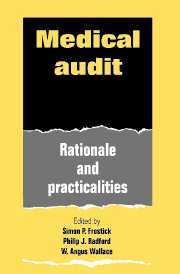Book contents
- Frontmatter
- Contents
- List of contributors
- Foreword
- Foreword
- 1 Introduction
- 2 Audit: historical and future perspectives
- 3 Audit philosophy
- 4 Medical audit: a view from the centre
- 5 Audit: a view from the Royal College of Surgeons of England
- 6 The regional viewpoint
- 7 Medical audit: the needs of the District Health Authorities
- 8 Resource management and budget holding
- 9 Unit and district information systems
- 10 Read codes and medical audit
- 11 Data capture direct from doctors
- 12 Computer systems: practice, limitations and pitfalls
- 13 Paediatric audit
- 14 Audit in obstetrics and gynaecology
- 15 Audit in general surgery
- 16 Orthopaedic audit: guidelines and hints
- 17 Installing audit in general practice and general dental practice
- 18 Clinical audit in psychiatry. Models for audit in mental health
- 19 Audit in anaesthesia
- 20 Audit in intensive care
- 21 Medical audit: lessons from the USA
- 22 Quality control in health care: the Dutch experience
- 23 Medical audit: experience from Sweden
- 24 Performance indicators
- 25 Measuring outcome and quality control
- 26 Audit: will it work?
- 27 What has been achieved so far?
- 28 A practical guide to audit
- Index
12 - Computer systems: practice, limitations and pitfalls
Published online by Cambridge University Press: 30 September 2009
- Frontmatter
- Contents
- List of contributors
- Foreword
- Foreword
- 1 Introduction
- 2 Audit: historical and future perspectives
- 3 Audit philosophy
- 4 Medical audit: a view from the centre
- 5 Audit: a view from the Royal College of Surgeons of England
- 6 The regional viewpoint
- 7 Medical audit: the needs of the District Health Authorities
- 8 Resource management and budget holding
- 9 Unit and district information systems
- 10 Read codes and medical audit
- 11 Data capture direct from doctors
- 12 Computer systems: practice, limitations and pitfalls
- 13 Paediatric audit
- 14 Audit in obstetrics and gynaecology
- 15 Audit in general surgery
- 16 Orthopaedic audit: guidelines and hints
- 17 Installing audit in general practice and general dental practice
- 18 Clinical audit in psychiatry. Models for audit in mental health
- 19 Audit in anaesthesia
- 20 Audit in intensive care
- 21 Medical audit: lessons from the USA
- 22 Quality control in health care: the Dutch experience
- 23 Medical audit: experience from Sweden
- 24 Performance indicators
- 25 Measuring outcome and quality control
- 26 Audit: will it work?
- 27 What has been achieved so far?
- 28 A practical guide to audit
- Index
Summary
Introduction
The most difficult thing facing the clinician interested in setting up audit within his/her department must be the means of acquisition, storage and analysis of the data required to support this. Computers are particularly good at storing large amounts of data and at manipulating them, and the enormous advantages of computerisation in aiding these functions have not escaped a large number of clinicians. Many have gone ahead and developed their ‘own’ computer software to aid their ‘audit’ activities, and several commercial systems have also been developed. It is important to realise however that there are no ‘audit systems’, despite the claims of the advocates and salesmen, that will perform all the needs of audit. Rather audit requires the active input of the practising clinician and cannot be done by a computer system alone. The computer can of course be a completely invaluable ‘audit assistant’ but it is never more than that.
As usual in life whenever one finds a multitude of different approaches to the same thing it usually means that none of them are perfect and that they all have different faults. The perfect solution will be obvious if it arrives. In orthopaedic surgery we see this for example in the 60 or so different operations described for the treatment of bunions (hallux valgus), and in the audit field we see it in the plethora of computer systems aimed at the audit market.
- Type
- Chapter
- Information
- Medical Audit , pp. 156 - 171Publisher: Cambridge University PressPrint publication year: 1993
- 1
- Cited by

